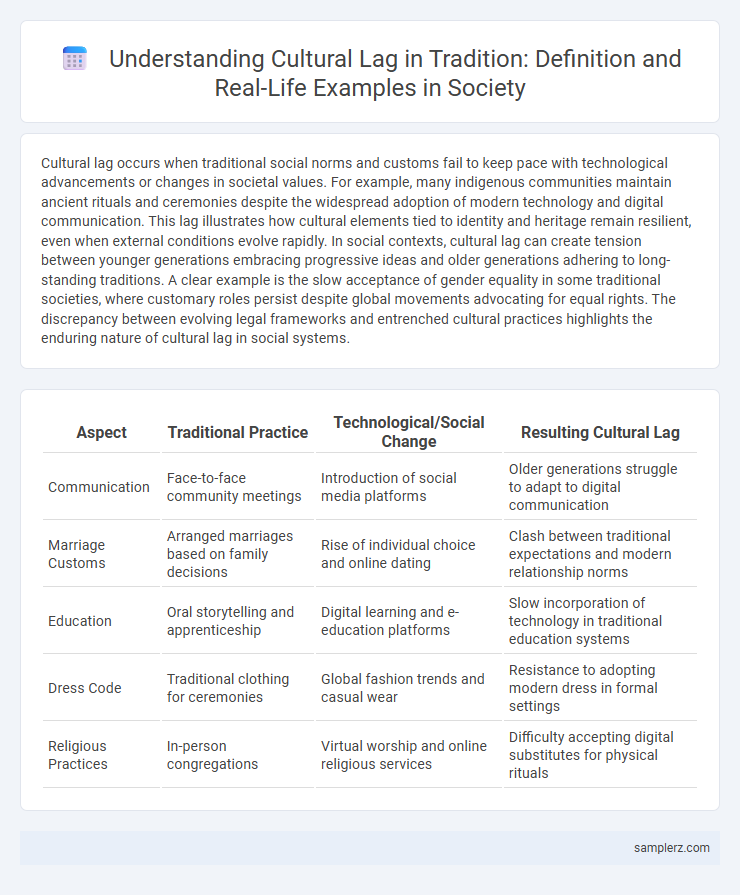Cultural lag occurs when traditional social norms and customs fail to keep pace with technological advancements or changes in societal values. For example, many indigenous communities maintain ancient rituals and ceremonies despite the widespread adoption of modern technology and digital communication. This lag illustrates how cultural elements tied to identity and heritage remain resilient, even when external conditions evolve rapidly. In social contexts, cultural lag can create tension between younger generations embracing progressive ideas and older generations adhering to long-standing traditions. A clear example is the slow acceptance of gender equality in some traditional societies, where customary roles persist despite global movements advocating for equal rights. The discrepancy between evolving legal frameworks and entrenched cultural practices highlights the enduring nature of cultural lag in social systems.
Table of Comparison
| Aspect | Traditional Practice | Technological/Social Change | Resulting Cultural Lag |
|---|---|---|---|
| Communication | Face-to-face community meetings | Introduction of social media platforms | Older generations struggle to adapt to digital communication |
| Marriage Customs | Arranged marriages based on family decisions | Rise of individual choice and online dating | Clash between traditional expectations and modern relationship norms |
| Education | Oral storytelling and apprenticeship | Digital learning and e-education platforms | Slow incorporation of technology in traditional education systems |
| Dress Code | Traditional clothing for ceremonies | Global fashion trends and casual wear | Resistance to adopting modern dress in formal settings |
| Religious Practices | In-person congregations | Virtual worship and online religious services | Difficulty accepting digital substitutes for physical rituals |
Understanding Cultural Lag in Traditional Practices
Cultural lag occurs when traditional practices persist despite advancements in technology or societal values, such as the continued use of outdated agricultural rituals in modern farming communities. These practices often reflect deep-rooted beliefs and social norms that adapt slower than technological changes, creating a gap between current capabilities and cultural acceptance. Understanding cultural lag highlights the challenges communities face in balancing heritage preservation with progress, emphasizing the importance of education and dialogue to bridge this divide.
The Persistence of Outdated Customs in Modern Societies
The persistence of outdated customs in modern societies exemplifies cultural lag, where traditional practices such as arranged marriages and caste-based social interactions endure despite rapid technological and economic advancements. These customs often clash with contemporary values emphasizing individual rights and social mobility, highlighting a disconnect between evolving societal needs and entrenched cultural norms. This lag in adapting traditional frameworks to current realities can hinder social progress and reinforce systemic inequalities.
Traditional Healing Practices: Clashing with Modern Medicine
Traditional healing practices, such as herbal remedies and spiritual rituals, often clash with modern medical approaches due to differing beliefs about health and treatment efficacy. This cultural lag creates tension as communities simultaneously rely on ancestral knowledge while accessing advanced diagnostic technologies and pharmaceuticals. The persistence of these traditional methods illustrates how deep-rooted cultural values can slow the full integration of scientific healthcare innovations.
Gender Roles: Tradition vs. Contemporary Equality
Gender roles in many cultures exemplify cultural lag as traditional expectations often persist despite contemporary movements toward equality. For instance, women in certain societies remain expected to prioritize domestic responsibilities even though legal frameworks and social activism promote equal opportunities in education and employment. This discrepancy highlights the tension between enduring cultural norms and evolving social values regarding gender equality.
Marriage Customs: Slow Adaptation to Social Change
Marriage customs often exemplify cultural lag, as traditional rituals and expectations persist despite evolving social norms regarding gender roles and individual autonomy. For instance, arranged marriages and dowry practices continue in many societies even as legal frameworks and public attitudes shift toward gender equality and personal choice. This slow adaptation highlights the tension between deeply rooted cultural traditions and the accelerating pace of social change.
Rituals and Ceremonies: Holding On to the Past
Cultural lag in rituals and ceremonies is evident when traditional practices persist despite societal advancements, such as using outdated rites in modern weddings that no longer reflect contemporary values. For example, arranged marriages continue in some communities despite widespread acceptance of individual choice and gender equality. This adherence to past customs highlights the tension between evolving social norms and the desire to maintain cultural heritage.
Traditional Dress Codes: Navigating Modern Identity
Traditional dress codes often struggle to keep pace with contemporary societal values, reflecting a cultural lag where long-standing customs clash with evolving identity norms. For instance, traditional attire may symbolize heritage and community belonging but can conflict with modern ideas of gender expression and individualism. This tension illustrates how cultural lag manifests in the negotiation between preserving tradition and embracing progressive social change.
Taboos and Beliefs: When Tradition Blocks Progress
Cultural lag occurs when deeply rooted taboos and beliefs resist social change, hindering progress despite advancements in knowledge and technology. For example, certain traditions forbid discussions around mental health, preventing timely intervention and support. This resistance perpetuates stigma, limiting community well-being and the adoption of modern healthcare practices.
Generational Gaps: Youth Challenging Traditional Norms
Generational gaps showcase cultural lag as youth challenge traditional norms around marriage, gender roles, and communication styles, creating tension between long-standing cultural expectations and evolving social values. Rapid technological advancements and globalization expose younger generations to diverse worldviews, accelerating shifts in attitudes that older generations struggle to accept. This dynamic often results in conflicts over family hierarchy, education priorities, and social behaviors, illustrating how cultural lag hinders smooth social adaptation.
Education and Tradition: Bridging the Cultural Lag
Traditional educational systems often struggle to integrate rapidly evolving technological tools, creating a cultural lag that hinders students' readiness for modern challenges. For example, curricula centered on rote memorization may not align with the demand for critical thinking and digital literacy in today's workforce. Bridging this gap requires revising educational practices to reflect contemporary societal values while respecting cultural heritage.

example of cultural lag in tradition Infographic
 samplerz.com
samplerz.com